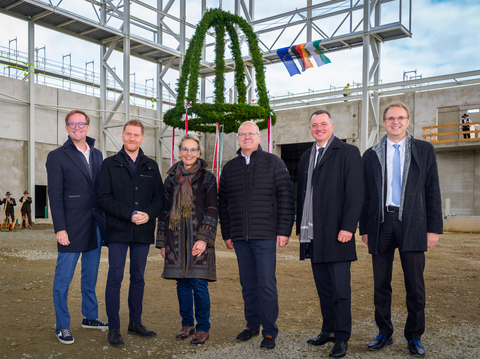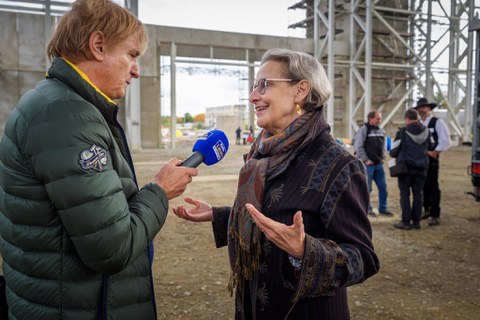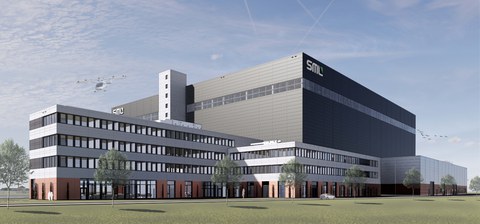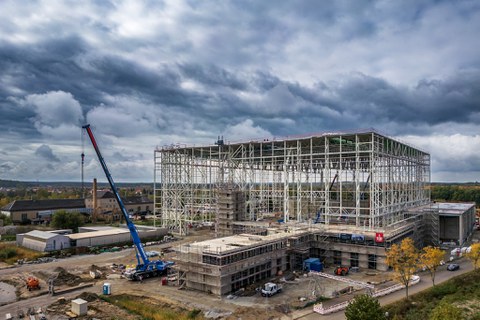Oct 17, 2025
Lusatia to host research center for future mobility that is unique in Europe

Feierlichkeiten zum Richtfest des SML: Jan-Hendrik Goldbeck, geschäftsführender Gesellschafter Goldbeck GmbH, Sachsens Ministerpräsident Michael Kretschmer, TUD-Rektorin Prof.in Ursula Staudinger, Torsten Ruban-Zeh, Oberbürgermeister der Stadt Hoyerswerda, Udo Witschas, Landrat des Landkreises Bautzen, und Prof. Günther Prokop, Professur für Kraftfahrzeugtechnik an der TUD (v.l.n.r.).
Essential contribution to both structural change in Lusatia and tomorrow's mobility: With today's topping-out ceremony, TUD Dresden University of Technology has reached an essential milestone in the construction of the Smart Mobility Lab (SML). On the research campus in the Schwarzkollm district of Hoyerswerda, a driving and flight test hall is being built as a research infrastructure for networked and automated mobility. Its dimensions are impressive - 42 meters in height and an area of around 1 hectare. This completed hall will be unique in Europe.
At the SML, scientists will develop new solutions for the emission-free, connected, automated, and safe mobility of the future. These include projects on automated road traffic, autonomous flight systems, and robot-assisted applications in agriculture.
The invested capital amounts to over EUR 86 million and consists primarily of German federal and state funding for structural change. TUD assumes construction ownership of the project, which is being carried out by Goldbeck Ost GmbH. Construction is scheduled for completion at the end of 2026, with operations set to begin in January 2027.
Research campus with significant impact beyond Lusatia
In the presence of Saxony's Minister President Michael Kretschmer, the Mayor of Hoyerswerda, Torsten Ruban-Zeh, representatives of Goldbeck, and future users of the SML, TUD Rector Prof. Ursula Staudinger emphasized the particular relevance of the project:
”Today's topping-out ceremony for the Smart Mobility Lab marks a major milestone on our journey to actively shape structural change as part of the TUD Lusatia Campus – towards a region that stands for cutting-edge research and technological innovation. The SML is creating a research platform that is unique in Europe, bringing together science, business, and society – in line with our self-image as The Collaborative University: inventive, transformative, engaged. This is where pioneering technologies for the automated and connected mobility of the future will be developed, tested, and put into practice – from road traffic to autonomous flight. The SML exemplifies our understanding of a university for the 21st century, combining interdisciplinary top-class research with practical applications and benefits for our society.”
Michael Kretschmer, Minister President of Saxony: ”Promoting modern mobility is an essential part of the Free State of Saxony's innovation strategy. The new Smart Mobility Lab in Hoyerswerda is a prime example of how important future technologies with global reach are being developed in Saxony. With the TU research campus, we are strengthening economic development and creating new opportunities for the people of Upper Lusatia. That's Saxony!”
Torsten Ruban-Zeh, Lord Mayor of the City of Hoyerswerda: ”The Smart Mobility Lab and the subsequent SCART Institute will create over 300 new jobs, expand the infrastructure of the city, and connect us more closely than ever before with TU Dresden. Moreover, the community will consolidate its international character and diversity.”
State-of-the-art infrastructure for mobility of the future
The SML will serve as an interdisciplinary research platform focusing on areas such as emission-free, intelligent, and safe mobility. The research center will provide ideal conditions for this, including a networked research environment that realistically simulates complex driving scenarios. The research projects range from safe automated road traffic (SivaS) and autonomous flight systems (TAFAS) to robotic solutions in agriculture (FarmingSwarm-Cobots, TERECULT).
Background: Construction progress and schedule
Construction of the Smart Mobility Lab is progressing faster than planned. For the deep foundations, around 1,300 precast piles, each 20 meters long, were driven into the ground to reliably transfer the loads of the future hall. The subsequent steel construction was carried out entirely in Saxony: All supports and trusses were manufactured in the Saxon town of Treuen; the two main girders, each around 100 meters long and weighing 210 tons, were manufactured by the steel construction company Stahlbau Ruhland. Assembly took place at the end of August 2025 with the help of three large cranes.
The steel construction work has now been completed, the roof is closed, and the facade work will also be finished by the end of the year, meaning that the building will "waterproof" before the turn of the year. It is particularly noteworthy that the steel construction work was completed around two weeks ahead of schedule.The building is scheduled for completion at the end of 2026, so that it can be put into operation at the beginning of 2027.
Background: Future-proof energy concept
A special feature of the Smart Mobility Lab is its innovative and forward-looking energy concept: From 2027, the building is expected to be more than 75 percent energy self-sufficient. To this end, a large-scale photovoltaic system, geothermal energy, an electrolyzer for hydrogen production, and a combined heat and power plant with battery and solid energy storage will be combined. This complex energy management system ensures a stable supply even during the dark seasons and at night. In this way, TU Dresden is sending a strong signal for sustainability and future viability, not only in research but also in building operations.
A symposium will be held at the site as early as November 17, 2025, to present the planned energy supply for the research center. Electromobility is also taken care of: In the future, the center's own charging stations will be powered directly by electricity from its in-house energy supply.
Background: TUD|Lusatia Campus – Supporting structural change
Along with partners from business, society, and politics, TU Dresden strives to help shape structural change in the region in order to promote ecologically and economically sustainable development and continue to boost interest in the Free State of Saxony. The construction of the Smart Mobility Lab in Hoyerswerda is an example of structural development in the former lignite mining region of Upper Lusatia. In addition to expanding urban infrastructure and creating new jobs, the aim is also to promote the establishment of start-ups and to strengthen regional economic development overall.
More information and projects as part of TUD|Lusatia Campus: https://tu-dresden.de/forschung-transfer/strukturwandel
Funding
The Smart Mobility Lab is funded on the basis of a resolution of the German Bundestag and is partly financed by tax revenue on the basis of the budget adopted by the Saxon State Parliament. The Dresden Driving Simulator is funded by the Federal Ministry of Digital and Transport.



